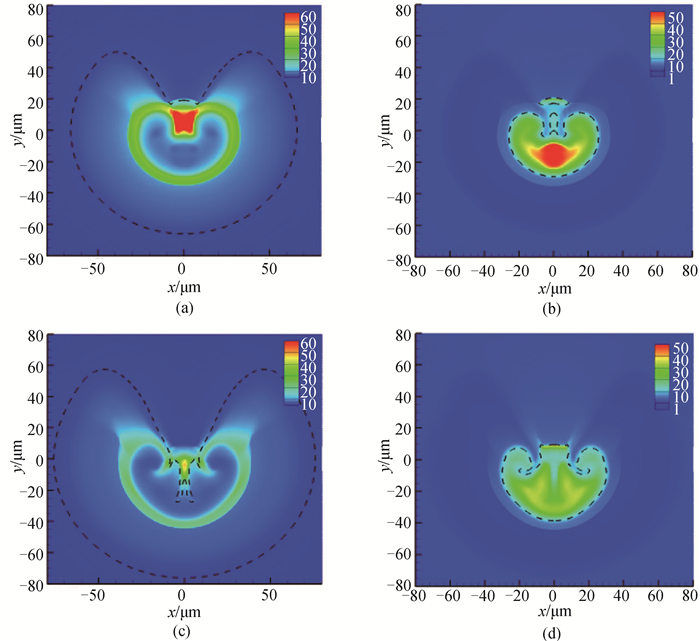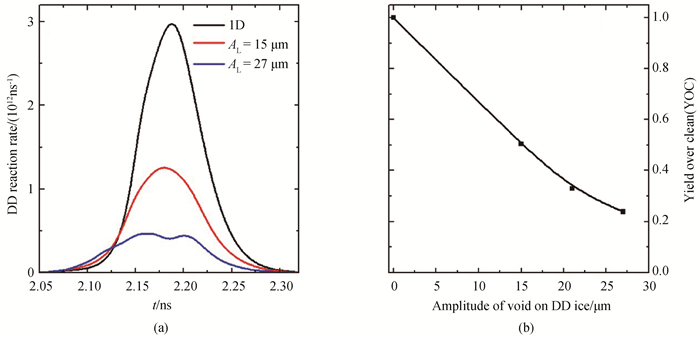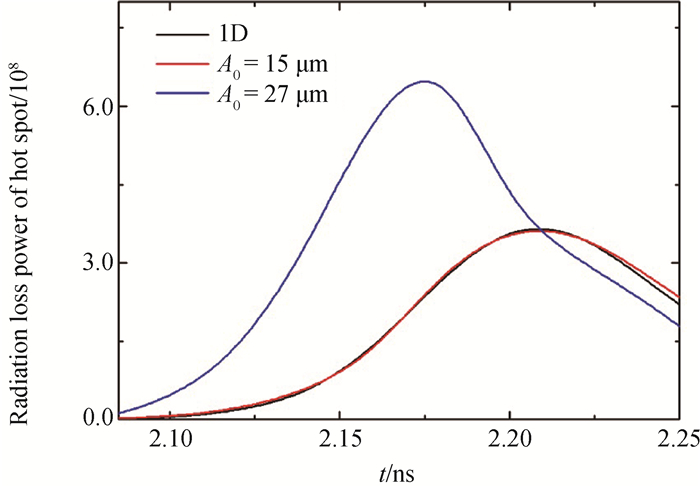Chinese Journal of Computational Physics ›› 2022, Vol. 39 ›› Issue (3): 268-276.DOI: 10.19596/j.cnki.1001-246x.8429
• Research Reports • Previous Articles Next Articles
Jianfa GU( ), Fengjun GE*(
), Fengjun GE*( ), Zhensheng DAI, Dongguo KANG, Shiyang ZOU
), Zhensheng DAI, Dongguo KANG, Shiyang ZOU
Received:2021-07-24
Online:2022-05-25
Published:2022-09-02
Contact:
Fengjun GE
Jianfa GU, Fengjun GE, Zhensheng DAI, Dongguo KANG, Shiyang ZOU. Influence of Penetrating Defect in DD Ice Layer on ICF Cryogenic Capsule Implosion Performance[J]. Chinese Journal of Computational Physics, 2022, 39(3): 268-276.
Add to citation manager EndNote|Ris|BibTeX
URL: http://www.cjcp.org.cn/EN/10.19596/j.cnki.1001-246x.8429

Fig.5 (a) Density and (b) ion temperature profiles at bang-time for the case of AL=15 μm; (c) Density and (d) ion temperature profiles for the case of AL= 27 μm

Fig.8 (a) DD reaction rate as a function of time for the 1D ideal implosion (black curve) and 2D implosion simulation with AL=15 μm (red curve) and AL=27 μm (blue curve); (b) 2D yield over clean (YOC) as a function of the amplitude of void on the inner DD interface

Fig.9 Loss power of the bremsstrahlung radiation from the hot spot as a function of time for the 1D implosion (black curve) and 2D simulation with AL=15 μm (red curve) and 27 μm (blue curve) for a void defect on the DD ice
| 1 |
DOI |
| 2 |
DOI |
| 3 |
|
| 4 |
DOI |
| 5 |
DOI |
| 6 |
DOI |
| 7 |
DOI |
| 8 |
DOI |
| 9 |
DOI |
| 10 |
|
| 11 |
|
| 12 |
DOI |
| 13 |
DOI |
| 14 |
|
| 15 |
|
| 16 |
|
| 17 |
DOI |
| 18 |
DOI |
| 19 |
DOI |
| 20 |
DOI |
| 21 |
DOI |
| 22 |
DOI |
| [1] | Xiaoyan HU, Zhengfeng FAN. An Efficient Parallel Algorithm on Multi-block Structure Meshes for Radiation Diffusion in Inertial Confinement Fusion Implosion [J]. Chinese Journal of Computational Physics, 2022, 39(3): 277-285. |
| [2] | GU Jianfa, GE Fengjun, DAI Zhensheng, ZOU Shiyang. Influence of Capsule Support Tent on ICF Capsule Implosion Performance: Simulation Study [J]. CHINESE JOURNAL OF COMPUTATIONAL PHYSICS, 2020, 37(6): 631-638. |
| [3] | YU Chengxin, FAN Zhengfeng, LIU Jie, HE Xiantu. Modeling of Shell-mixing into Central Hotspot in Inertial Confinement Fusion Implosion [J]. CHINESE JOURNAL OF COMPUTATIONAL PHYSICS, 2017, 34(4): 379-386. |
| [4] | GU Jianfa, DAI Zhensheng, GU Peijun, YE Wenhua, ZHENG Wudi, ZOU Shiyang. Simulations of Mode-Mode Coupling Between Drive Asymmetry and Outer Surface Roughness in Ignition Capsule Implosion [J]. CHINESE JOURNAL OF COMPUTATIONAL PHYSICS, 2016, 33(6): 645-651. |
| [5] | GU Jianfa, DAI Zhensheng, YE Wenhua, GU Peijun, ZHENG Wudi. Simulation of High-Adiabat ICF Capsule Implosion [J]. CHINESE JOURNAL OF COMPUTATIONAL PHYSICS, 2015, 32(6): 662-668. |
| [6] | ZENG Qinghong, PEI Wenbing, CHENG Juan, YONG Heng. Extension of Kershaw Diffusion Scheme on Multi.block Grids [J]. CHINESE JOURNAL OF COMPUTATIONAL PHYSICS, 2011, 28(5): 641-648. |
| [7] | LI Shoufu, YE Wenhua, ZHANG Yuan, SHU Shi, XIAO Aiguo. High Order FD-WENO Schemes for Rayleigh-Taylor Instability Problems [J]. CHINESE JOURNAL OF COMPUTATIONAL PHYSICS, 2008, 25(4): 379-386. |
| [8] | JIANG Jun, SHU Shi, HUANG Yunqing, CHEN Long. A Mesh Adaptive Method for Two-Dimensional Three-Tempeature Heat Conduction Equations [J]. CHINESE JOURNAL OF COMPUTATIONAL PHYSICS, 2007, 24(1): 19-28. |
| [9] | QI Jin, YE Wen-hua. THREE-DIMENSIONAL PARALLEL COMPUTATION OF LASER ABLATIVE RAYLEIGH-TAYLOR INSTABILITY [J]. CHINESE JOURNAL OF COMPUTATIONAL PHYSICS, 2002, 19(5): 388-392. |
| [10] | Chen Guangnan, Chang Tieqiang, Zhang Jun, Zhang Xinghong, Pei Wenbing, You Xiwen. NUMERICAL SIMULATION FOR LASER-TARGET NONEQUILIBRIUM COUPLING [J]. CHINESE JOURNAL OF COMPUTATIONAL PHYSICS, 1998, 15(4): 409-418. |
| [11] | Ye Wenhua, Zhang Weiyan, Chen Guangnan, Jin Changqiu, Zhang Jun. NUMERICAL SIMULATIONS OF THE FCT METHOD ON RAYLEIGH-TAYLOR AND RICHTMYER-MESHKOV INSTABILITIES [J]. CHINESE JOURNAL OF COMPUTATIONAL PHYSICS, 1998, 15(3): 277-282. |
| [12] | Jiang Shao'en, Liu Zhongli, Li Nan, Zheng Zhijian, Tang Dangyuan, Ding Yongkun, Hu Xin. NUMERICAL STUDY ON THREE DIMENSIONAL IMAGING OF ICF TARGETS [J]. CHINESE JOURNAL OF COMPUTATIONAL PHYSICS, 1997, 14(3): 361-367. |
| Viewed | ||||||
|
Full text |
|
|||||
|
Abstract |
|
|||||
Copyright © Chinese Journal of Computational Physics
E-mail: jswl@iapcm.ac.cn
Supported by Beijing Magtech Co., Ltd.
